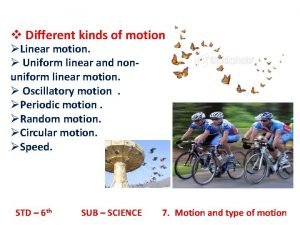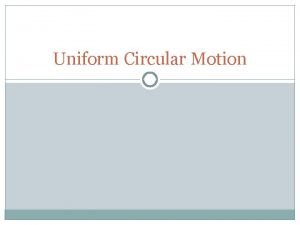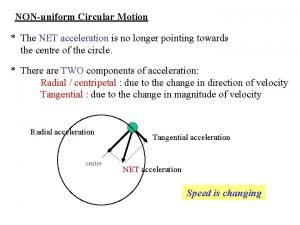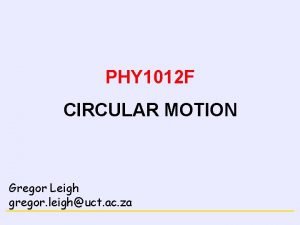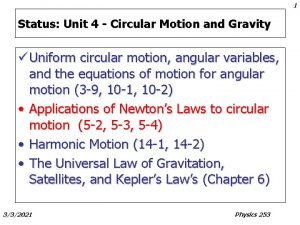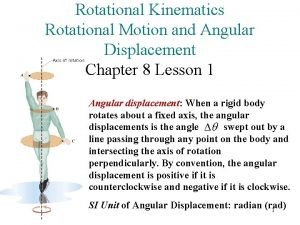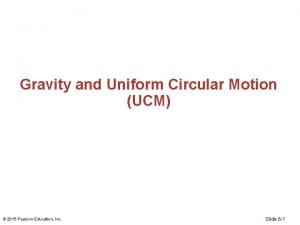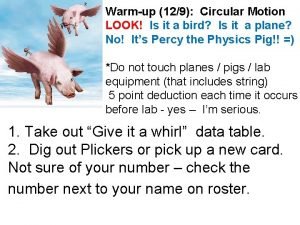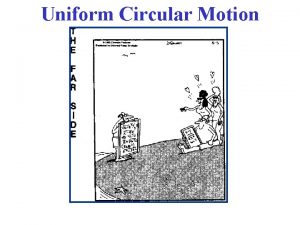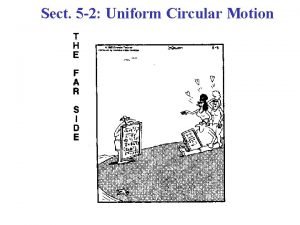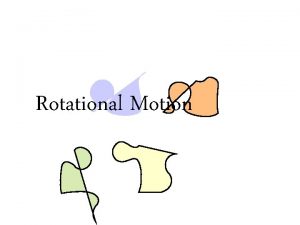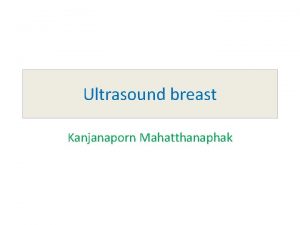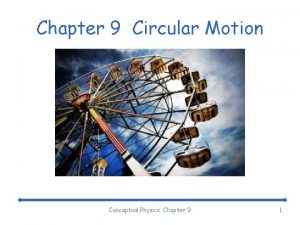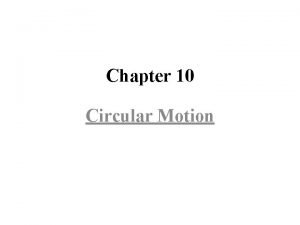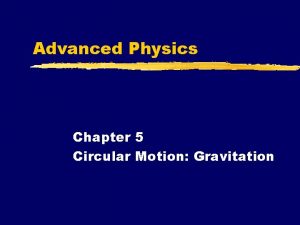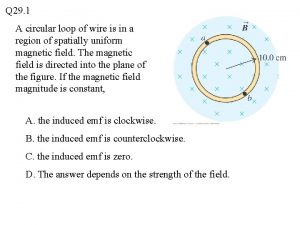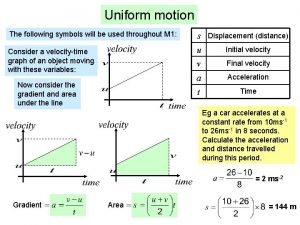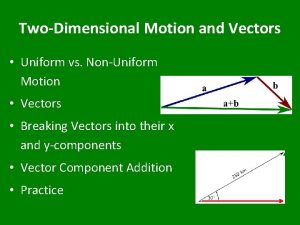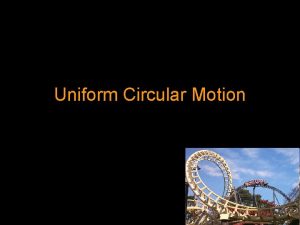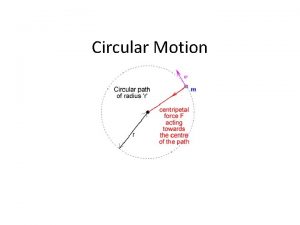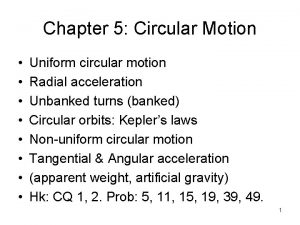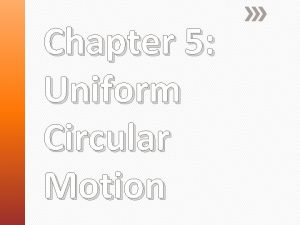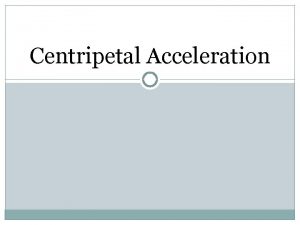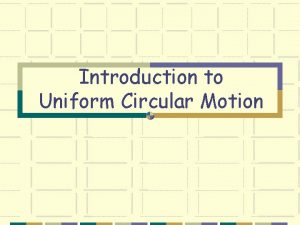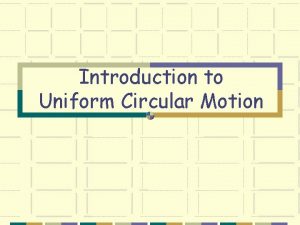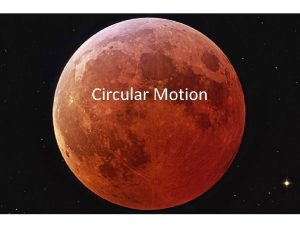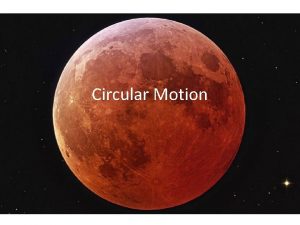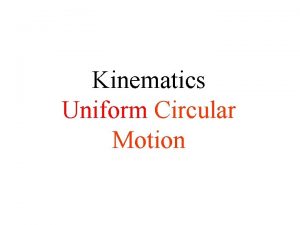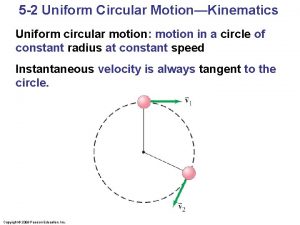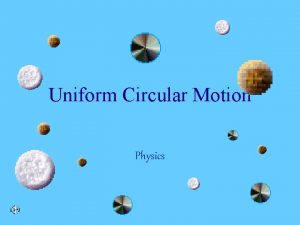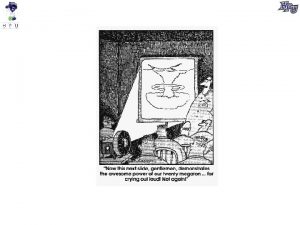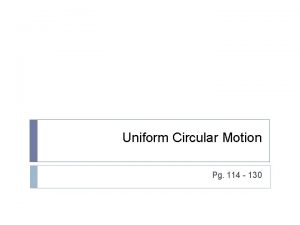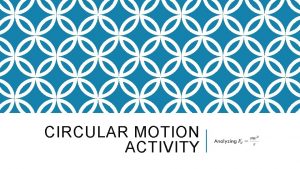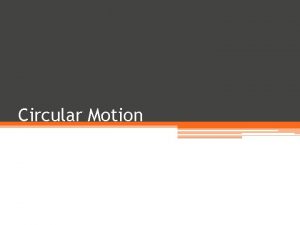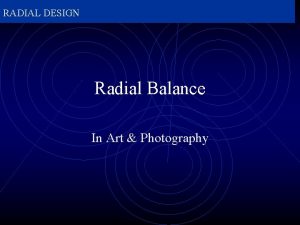Chapter 5 Circular Motion Uniform circular motion Radial



























- Slides: 27

Chapter 5: Circular Motion • • Uniform circular motion Radial acceleration Unbanked turns (banked) Circular orbits: Kepler’s laws Non-uniform circular motion Tangential & Angular acceleration (apparent weight, artificial gravity) Hk: CQ 1, 2. Prob: 5, 11, 15, 19, 39, 49. 1

angular measurement • degrees (arbitrary numbering system, e. g. some systems use 400) • radians (ratio of distances) • e. g. distance traveled by object is product of angle and radius. 2

Radians s = arc length r = radius 3

motion tangent to circle 4

Angular Motion • radian/second (radian/second)/second 5

angular conversions Convert 30° to radians: Convert 15 rpm to radians/s 6

Angular Equations of Motion Valid for constant-a only 7

Centripetal Acceleration • Turning is an acceleration toward center of turn-radius and is called Centripetal Acceleration • Centripetal is left/right direction • a(centripetal) = v 2/r • (v = speed, r = radius of turn) • Ex. V = 6 m/s, r = 4 m. a(centripetal) = 6^2/4 = 9 m/s/s 8

Centripetal Force f f Top View Back View

Acceleration with Non-Uniform Circular Motion • Total acceleration = tangential + centripetal • = forward/backward + left/right • a(total) = ra (F/B) + v 2/r (L/R) • Ex. Accelerating out of a turn; 4. 0 m/s/s (F) + 3. 0 m/s/s (L) • a(total) = 5. 0 m/s/s

Centripetal Force • required for circular motion • Fc = mac = mv 2/r • • Example: 1. 5 kg moves in r = 2 m circle v = 8 m/s. ac = v 2/r = 64/2 = 32 m/s/s Fc = mac = (1. 5 kg)(32 m/s/s) = 48 N 11

Rounding a Corner • How much horizontal force is required for a 2000 kg car to round a corner, radius = 100 m, at a speed of 25 m/s? • Answer: F = mv 2/r = (2000)(25)/(100) = 12, 500 N • What percent is this force of the weight of the car? • Answer: % = 12, 500/19, 600 = 64% 12

Mass on Spring 1 • A 1 kg mass attached to spring does r = 0. 15 m circular motion at a speed of 2 m/s. What is the tension in the spring? • Answer: T = mv 2/r = (1)(2)(2)/(. 15) = 26. 7 N 13

Mass on Spring 2 • A 1 kg mass attached to spring does r = 0. 15 m circular motion with a tension in the spring equal to 9. 8 N. What is the speed of the mass? • Answer: T = mv 2/r, v 2 = Tr/m • v = sqrt{(9. 8)(0. 15)/(1)} = 1. 21 m/s 14

Kepler’s Laws 15

Kepler’s Laws of Orbits 1. Elliptical orbits 2. Equal areas in equal times (ang. Mom. ) 3. Square of year ~ cube of radius

Elliptical Orbits • • One side slowing, one side speeding Conservation of Mech. Energy ellipse shape simulated orbits

Summary • • • s = rq v = rw a(tangential) = ra. a(centripetal) = v 2/r F(grav) = GMm/r 2 Kepler’s Laws, Energy, Angular Momentum 18

Centrifugal Force • The “apparent” force on an object, due to a net force, which is opposite in direction to the net force. • Ex. A moving car makes a sudden turn to the left. You feel forced to the right of the car. • Similarly, if a car accelerates forward, you feel pressed backward into the seat. 19

rotational speeds • • • rpm = rev/min frequency “f” = cycles/sec period “T” = sec/cycle = 1/f degrees/sec rad/sec w = 2 pf 20

7 -43 • • Merry go round: 24 rev in 3. 0 min. W-avg: 0. 83 rad/s V = rw = (4 m)(0. 83 rad/s) = 3. 3 m/s V = rw = (5 m)(0. 83 rad/s) = 4. 2 m/s

Rolling Motion v = vcm = Rw 22

Example: Rolling A wheel with radius 0. 25 m is rolling at 18 m/s. What is its rotational rate? 23

Example A car wheel angularly accelerates uniformly from 1. 5 rad/s with rate 3. 0 rad/s 2 for 5. 0 s. What is the final angular velocity? What angle is subtended during this time? 24

Ex: Changing Units 25

Rotational Motion vt at ac r vt ac 26

Convert 50 rpm into rad/s. • (50 rev/min)(6. 28 rad/rev)(1 min/60 s) • 5. 23 rad/s
 Type of motion
Type of motion Circular motion lab
Circular motion lab Net acceleration in circular motion
Net acceleration in circular motion Learning objectives for newton's laws of motion
Learning objectives for newton's laws of motion Non uniform circular motion examples
Non uniform circular motion examples Dynamics of uniform circular motion
Dynamics of uniform circular motion Acceleration vector projectile motion
Acceleration vector projectile motion Instantaneous angular velocity
Instantaneous angular velocity Apparent weight formula
Apparent weight formula Centripetal acceleration symbol
Centripetal acceleration symbol What is uniform circular motion
What is uniform circular motion Constant speed in circular motion
Constant speed in circular motion Circular velocity formula
Circular velocity formula Anti radial vs radial ultrasound
Anti radial vs radial ultrasound How do you classify uniform and non-uniform mixtures?
How do you classify uniform and non-uniform mixtures? Examples of pure substances
Examples of pure substances Pengertian aliran seragam
Pengertian aliran seragam Chapter 9 circular motion answers
Chapter 9 circular motion answers Chapter 10 circular motion
Chapter 10 circular motion Chapter 5 circular motion gravitation
Chapter 5 circular motion gravitation A circular loop of wire and a long straight wire
A circular loop of wire and a long straight wire Chapter 2 section 1 describing motion answer key
Chapter 2 section 1 describing motion answer key Describing and measuring motion
Describing and measuring motion Chapter 2 motion section 1 describing motion answer key
Chapter 2 motion section 1 describing motion answer key What are the 5 elements of hair design
What are the 5 elements of hair design Uniform linear motion examples
Uniform linear motion examples Uniform motion
Uniform motion Motion uniform and nonuniform
Motion uniform and nonuniform
